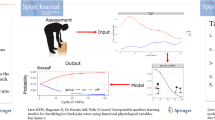Abstract
Objective
The five-repetition sit-to-stand (5R-STS) test was designed to capture objective functional impairment and thus provided an adjunctive dimension in patient assessment. The clinical interpretability and confounders of the 5R-STS remain poorly understood. In clinical use, it became apparent that 5R-STS performance may differ between patients with lumbar disk herniation (LDH), lumbar spinal stenosis (LSS) with or without low-grade spondylolisthesis, and chronic low back pain (CLBP). We seek to evaluate the extent of diagnostic information contained within 5R-STS testing.
Methods
Patients were classified into gold standard diagnostic categories based on history, physical examination, and imaging. Crude and adjusted comparisons of 5R-STS performance were carried out among the three diagnostic categories. Subsequently, a machine learning algorithm was trained to classify patients into the three categories using only 5R-STS test time and patient age, gender, height, and weight.
Results
From two prospective studies, 262 patients were included. Significant differences in crude and adjusted test times were observed among the three diagnostic categories. At internal validation, classification accuracy was 96.2% (95% CI 87.099.5%). Classification sensitivity was 95.7%, 100%, and 100% for LDH, LSS, and CLBP, respectively. Similarly, classification specificity was 100%, 95.7%, and 100% for the three diagnostic categories.
Conclusion
5R-STS performance differs according to the etiology of back and leg pain, even after adjustment for demographic covariates. In combination with machine learning algorithms, OFI can be used to infer the etiology of spinal back and leg pain with accuracy comparable to other diagnostic tests used in clinical examination.
Graphic abstract
These slides can be retrieved under Electronic Supplementary Material.


Similar content being viewed by others
References
Staartjes VE, Schröder ML (2018) The five-repetition sit-to-stand test: evaluation of a simple and objective tool for the assessment of degenerative pathologies of the lumbar spine. J Neurosurg Spine 29:380–387. https://doi.org/10.3171/2018.2.SPINE171416
Gautschi OP, Smoll NR, Corniola MV et al (2016) Validity and reliability of a measurement of objective functional impairment in lumbar degenerative disc disease: the timed up and go (TUG) test. Neurosurgery 79:270–278. https://doi.org/10.1227/NEU.0000000000001195
Gautschi OP, Corniola MV, Schaller K et al (2014) The need for an objective outcome measurement in spine surgery—the timed-up-and-go test. Spine J 14:2521–2522. https://doi.org/10.1016/j.spinee.2014.05.004
Gautschi OP, Joswig H, Corniola MV et al (2016) Pre- and postoperative correlation of patient-reported outcome measures with standardized timed up and go (TUG) test results in lumbar degenerative disc disease. Acta Neurochir (Wien) 158:1875–1881. https://doi.org/10.1007/s00701-016-2899-9
Guyatt GH, Sullivan MJ, Thompson PJ et al (1985) The 6-minute walk: a new measure of exercise capacity in patients with chronic heart failure. Can Med Assoc J 132:919–923
Joswig H, Stienen MN, Smoll NR et al (2017) Patients’ preference of the timed up and go test or patient-reported outcome measures before and after surgery for lumbar degenerative disk disease. World Neurosurg 99:26–30. https://doi.org/10.1016/j.wneu.2016.11.039
Staartjes VE, Beusekamp F, Schröder ML (2019) Can objective functional impairment in lumbar degenerative disease be reliably assessed at home using the five-repetition sit-to-stand test? A prospective study. Eur Spine J Off Publ Eur Spine Soc Eur Spinal Deform Soc Eur Sect Cerv Spine Res Soc. https://doi.org/10.1007/s00586-019-05897-3
Jones SE, Kon SSC, Canavan JL et al (2013) The five-repetition sit-to-stand test as a functional outcome measure in COPD. Thorax 68:1015–1020. https://doi.org/10.1136/thoraxjnl-2013-203576
Stienen MN, Ho AL, Staartjes VE et al (2019) Objective measures of functional impairment for degenerative diseases of the lumbar spine: a systematic review of the literature. Spine J. https://doi.org/10.1016/j.spinee.2019.02.014
Munakomi S (2019) Letter to the editor. reappraising role of clinical evaluations in degenerative lumbar spine pathologies. J Neurosurg Spine 30:860–861. https://doi.org/10.3171/2018.10.SPINE181282
Senders JT, Staples PC, Karhade AV et al (2018) Machine learning and neurosurgical outcome prediction: a systematic review. World Neurosurg 109:476–486.e1. https://doi.org/10.1016/j.wneu.2017.09.149
LeCun Y, Bengio Y, Hinton G (2015) Deep learning. Nature 521:436–444. https://doi.org/10.1038/nature14539
Collins GS, Reitsma JB, Altman DG, Moons KGM (2015) Transparent reporting of a multivariable prediction model for individual prognosis or diagnosis (TRIPOD): the TRIPOD statement. BMJ 350:g7594
Siccoli A, de Wispelaere MP, Schröder ML, Staartjes VE (2019) Machine learning-based preoperative predictive analytics for lumbar spinal stenosis. Neurosurg Focus 46:E5. https://doi.org/10.3171/2019.2.FOCUS18723
Core Team R (2018) R: a language and environment for statistical computing. R Foundation for Statistical Computing, Vienna
Siccoli A, Staartjes VE, de Wispelaere MP, Schröder ML (2018) Gender differences in degenerative spine surgery: Do female patients really fare worse? Eur Spine J. https://doi.org/10.1007/s00586-018-5737-3
Siccoli A, Staartjes VE, de Wispelaere MP, Schröder ML (2018) Is elective degenerative lumbar spine surgery in older adults safe in a short-stay clinic? Data from an institutional registry. Eur Geriatr Med. https://doi.org/10.1007/s41999-018-0132-5
Staartjes VE, Schröder ML (2018) Letter to the Editor. Class imbalance in machine learning for neurosurgical outcome prediction: are our models valid? Neurosurg Spine. https://doi.org/10.3171/2018.5.SPINE18543
Batista GEAPA, Prati RC, Monard MC (2004) A study of the behavior of several methods for balancing machine learning training data. SIGKDD Explor Newsl 6:20–29. https://doi.org/10.1145/1007730.1007735
Riza LS, Bergmeir C, Herrera F, Benítez JM (2015) frbs: fuzzy rule-based systems for classification and regression in R. J Stat Softw. https://doi.org/10.18637/jss.v065.i06
Kuncheva L (2000) Fuzzy classifier design. Springer
Ejupi A, Brodie M, Gschwind YJ et al (2015) Kinect-based five-times-sit-to-stand test for clinical and in-home assessment of fall risk in older people. Gerontology 62:118–124. https://doi.org/10.1159/000381804
Funding
This research did not receive any specific grant from funding agencies in the public, commercial, or not-for-profit sectors.
Author information
Authors and Affiliations
Corresponding author
Ethics declarations
Conflict of interest
The authors declare that the article and its content were composed in the absence of any commercial or financial relationships that could be construed as a potential conflict of interest.
Additional information
Publisher's Note
Springer Nature remains neutral with regard to jurisdictional claims in published maps and institutional affiliations.
Electronic supplementary material
Below is the link to the electronic supplementary material.
Rights and permissions
About this article
Cite this article
Staartjes, V.E., Quddusi, A., Klukowska, A.M. et al. Initial classification of low back and leg pain based on objective functional testing: a pilot study of machine learning applied to diagnostics. Eur Spine J 29, 1702–1708 (2020). https://doi.org/10.1007/s00586-020-06343-5
Received:
Revised:
Accepted:
Published:
Issue Date:
DOI: https://doi.org/10.1007/s00586-020-06343-5




